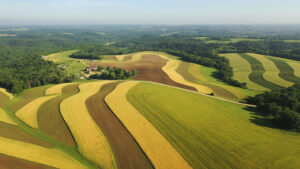The state of Wisconsin is expanding farmland preservation agreements and increasing the tax credits. Farmland Preservation gives financial incentives for farmers to keep their land in production while preserving soil and water quality.
Among the updates to the program created under the bill are the following:
- Reducing the minimum number of years a farmer would have to commit to the program from 15 to 10 years. This gives more flexibility and account for estate planning.
- Increase payments from $7.50 to $10 per acre for land located in a farmland preservation zoning district but not subject to a farmland preservation agreement.
- Increase payments from $5 to $10 per acre for land subject to a farmland preservation agreement but not located in a farmland preservation zoning district.
- Increase payments from $10 to $12.50 per acre for land located in a farmland preservation zoning district and are subject to a farmland preservation agreement.
Farmland Preservation Program Manager Wednesday Coye says she hopes these changes will help boost enrollment numbers.
“I do think that this will increase enrollment,” Coye says. “We have seen some counties offer some incentives for new enrollment in farmland preservation agreements at smaller scale, and we saw wild success with that.”
Farmland Preservation Program Manager Tim Jackson says there’s room for more farmers to enroll. Roughly 20 percent of eligible acres are enrolled in a preservation program.
Acres covered by the certified zoning districts total 7.2 million acres. The Agriculture Enterprise Areas total 1.6 million acres. Between the two, about 8.5 million acres are eligible. But just under 2 million acres are enrolled by roughly 9,700 landowners.
“Over the last 10 years, the number of total claims has decreased slowly over time,” he says.
On the flipside, Jackson says the number of acres per claim has slowly ticked up, reflecting trends in farm consolidation.
“Being that the tax credit has stayed the same and the cost of doing business has gone up, we can assume that some of those smaller to mid-tier farms have seen the program as not being worth the work it takes to participate in,” he says. “With the tax credit going up, we hope to see more of those smaller sized farms participate in this program.”
Buffalo County dairy farmer Dustin Ellis had been toying with the idea of enrolling. He says now that the state updated the program, it’s worth the paperwork.
“With the better incentive, with the $10 an acre, I think we’re going to be looking into it and signing up,” Ellis says. “I think that the farmland that we have is a valuable resource. I’d like to see it stay in farmland.”


